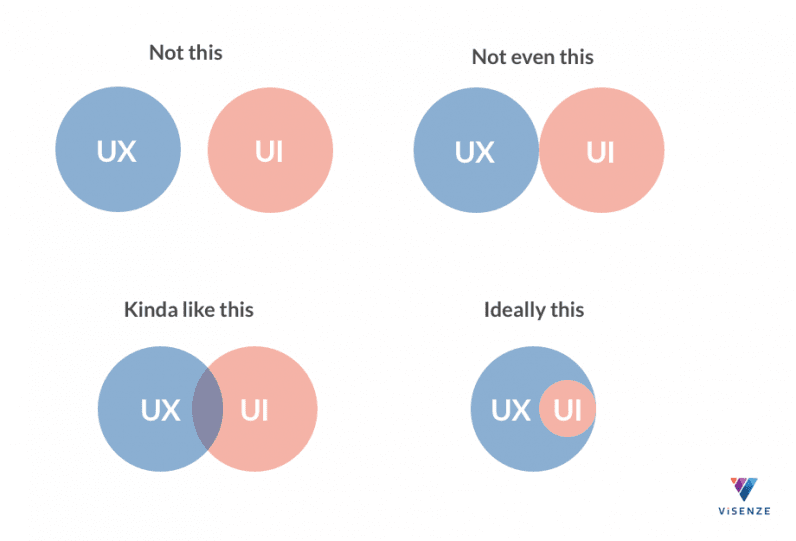
When my colleagues and I tell people that we are a UX/UI design team in an Artificial Intelligence company, we regularly get interesting responses or sometimes awkward silences.
Here are a few of the reactions and questions we get, hope it helps shed a light on what we actually do!
Misconception 1: UX and UI are the same thing
“Oh, you must be very good at designing beautiful interfaces!”
UX and UI are not mutually exclusive, but absolutely not the same thing. It’s nearly impossible to work on user experience without considering the user interfaces, and vice-versa.
“A beautiful product that doesn’t work very well is ugly” – Jonathan Ive, Apple

Misconception 2: UX/UI design is about digital stuff
“What are the digital products you worked on?” / “You’re surely good at all those design software”
One of the most common misconceptions in design is that UX is exclusive to digital design. In fact, any discipline involves a user has some kind of experience, for example, the branding design is all about user perception; the industrial design can be how users interact and feel when using the products.
[Read: ‘User in yer face’ is an online museum of design horrors]
The design doesn’t start or end at the edges of a user’s screen. Nor is it a layer or component of the product or service. It is the entire experience and an iterative process of the whole product cycle.
“You’ve got to start with the customer experience and work back toward the technology – not the other way around” – Steve Jobs

Misconception 3: User experience design is just about users
“Isn’t user experience all about USERS?”
It’s true that we place users throughout the entire design process, design involves understanding users’ needs, pains, goals and building user personas, planning of user journeys. It sounds right that the designer’s job is to meet users expectations and bring the joy of using the product.
However, UX design also has to meet business goals and objectives, it starts with an understanding of the product vision like, the reason for having this product from a business perspective, the target market to be considered, and the issues that this product can solve.
“User experience design is the science and art of designing a product so that it is – easy to use – fits expectations and – meets business goals” – Susan Weinschenk, CEO at Team W

Misconception 4: Design is a single discipline
“Design is an isolated principle, I don’t know when and how to include design in my business.”
Many believe that design is a single discipline, the truth is UX design is like an umbrella term for a vast universe of disciplines, approaches, methodologies, and tools. All of these contributes to the success of a product or service.
My all-time favorite description of the UX designer is this UX Unicorn illustration by Conor Ward, the unicorns are 10 prime cuts of the unicorns are the disciplines that we should master to become an extraordinary designer.

Misconception 5: Design is optional/good to have
“Can we work on the functions first, and then your design comes after?”
People are misguided to think the design is an addition or something come after the “important stuff.” In fact, just like defining business goals, marketing strategy, sales, product requirements and development resources, integrating design into everything a company does is as crucial. Design is not merely an option, it is an absolute must-have if companies are to succeed in the long run.
Without UX/UI design, the product will struggle to solve both user and business problems to come up with good user experience solutions. Imagine interior designers building a home’s interior design without understanding their client’s functional and aesthetic needs, the outcome will not be satisfactory and there will be many iterations involved to derive the final outcome.
Misconception 6: The designer always wears black
“Do you always wear black?”
Google autocompletes ‘why do designers…’ with the suggestion ‘always wear black.’ Iconic designers such as Steve Jobs had championed black as the Zen-tech uniform, he contributed to a public image of the designer in a simple black t-shirt or turtleneck.
In my career as a UX designer, I can’t recall coming across designers who always wear black (except for my teammate Lye Hoe, he occasionally wears other colors when he got no time to do laundry, but definitely no black turtlenecks, because of the hot and humid weather here in Singapore! ) Designers are mostly very stylish and love to dress up differently to express themselves.

Get the TNW newsletter
Get the most important tech news in your inbox each week.





